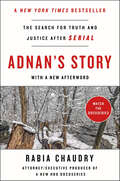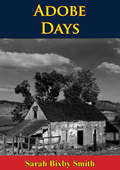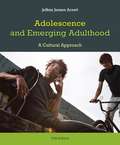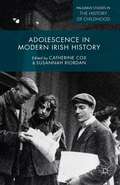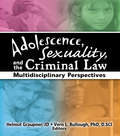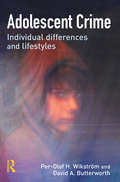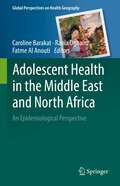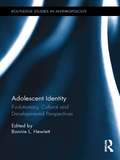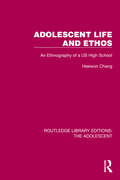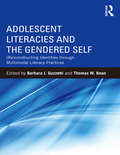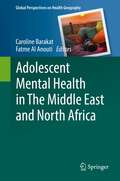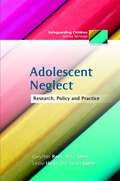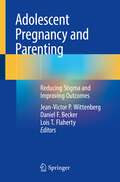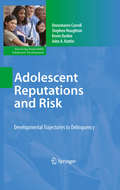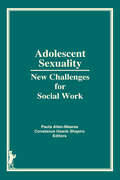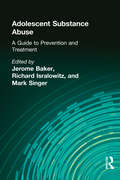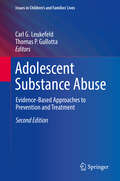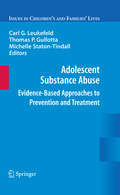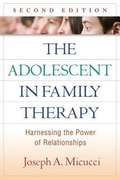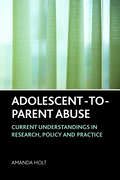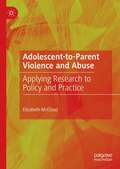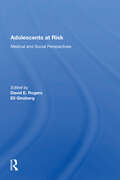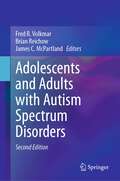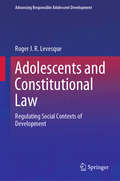- Table View
- List View
Adnan's Story: The Search for Truth and Justice After Serial
by Rabia ChaudryAfter more than twenty years in prison, Adnan Syed’s murder conviction was overturned, and he was finally set free. Rabia Chaudry’s New York Times bestseller and award-winner Adnan’s Story reveals how the case was mishandled and became the subject of Sarah Koenig’s Peabody Award-winning podcast Serial.In early 2000, Adnan Syed was convicted and sentenced to life plus thirty years for the murder of his ex-girlfriend Hae Min Lee, a high school senior in Baltimore, Maryland. Syed has maintained his innocence, and Rabia Chaudry, a family friend, has always believed him. By 2013, after almost all appeals had been exhausted, Rabia contacted Sarah Koenig, a producer at This American Life, in hopes of finding a journalist who could shed light on Adnan’s story. In 2014, Koenig's investigation turned into Serial, a Peabody Award-winning podcast with more than 500 million international listeners.But Serial did not tell the whole story. In this compelling narrative, Rabia Chaudry presents key evidence that she maintains dismantles the State’s case: a potential new suspect, forensics indicating Hae was killed and kept somewhere for almost half a day, and documentation withheld by the State that destroys the cell phone evidence—among many other points—and she shows how fans of Serial joined a crowd-sourced investigation into a case riddled with errors and strange twists. Featuring information about Adnan’s life in prison, and weaving in his personal reflections with never-before-seen letters, Rabia’s account is “a true story about real people. Adnan’s Story adds context and humanizes it in a way that could change how you think about the case and about Serial itself” (Los Angeles Times).“Chaudry’s clear, vivid and highly readable account of the case will bring the story to life for readers unfamiliar with the podcast, and even the most devoted Serial fans will find fresh insight and a vast amount of new material. Chaudry’s legal training serves her well as she marshals her defense, but so too does the Pakistani heritage and Muslim faith she shares with Syed.” —Washington Post
Adobe Days: Being The Truthful Narrative Of The Events In The Life Of A California Girl On A Sheep Ranch (large Print Edition)
by Sarah Bixby Smith"In this rollicking reminiscence Sarah Bixby Smith tells of Los Angeles when it was "a little frontier town" and "Bunker Hill Avenue was the end of the settlement, a row of scattered houses along the ridge." She came there in 1878 at the age of seven from the San Justo Rancho in Monterey County. Sarah recalls daily life in town and at San Justo and neighboring ranches in the bygone era of the adobes. Exerting a strong pull on her imagination, as it will on the reader's, is the story of how her family drove sheep and cattle from Illinois to the Pacific Coast in the 1850s. The daughter of a pioneering woolgrower, Sarah Bixby Smith became a leading citizen of California."-Print ed.
Adolescence and Emerging Adulthood: A Cultural Approach
by Jeffrey Jensen ArnettHelps students understand how culture impacts development in adolescence and emerging adulthood. Grounded in a global cultural perspective (within and outside of the US), this text enriches the discussion with historical context and an interdisciplinary approach, including studies from fields such as anthropology and sociology, in addition to the compelling psychological research on adolescent development. This book also takes into account the period of "emerging adulthood" (ages 18-25), a term coined by the author, and an area of study for which Arnett is a leading expert. Arnett continues the fifth edition with new and updated studies, both U. S. and international.
Adolescence in Modern Irish History: Innocence And Experience (Palgrave Studies in the History of Childhood)
by Catherine Cox Susannah RiordanThis edited collection is the first to address the topic of adolescence in Irish history. It brings together established and emerging scholars to examine the experience of Irish young adults from the 'affective revolution' of the early nineteenth century to the emergence of the teenager in the 1960s.
Adolescence, Sexuality, and the Criminal Law: Multidisciplinary Perspectives
by Vern L BulloughGain an understanding of the threat to freedom that is posed by state regulation of adolescent sexual behaviorSexual autonomy encompasses both the right to engage in wanted sexual activity and the right to be free and protected from unwanted sexual aggression. Only when both aspects of adolescents&’ rights are recognized can human sexual dignity be fully respected. In Adolescence, Sexuality, and the Criminal Law, experts from several disciplines use case studies, legal analysis, empirical examinations, and tables and figures to provide you with an insightful contribution to the debate surrounding child sexual abuse.Much has been written about the undisputedly essential fight against child sexual exploitation. In Adolescence, Sexuality, and the Criminal Law, experts investigate for the first time what distinguishes the sexual contacts of adolescents from those of children and why they should be treated separately. This updated version of the papers delivered to the International Association for the Treatment of Sex Offenders in 2002 is an essential guide for lawmakers, sexologists, psychologists, and lawyers interested in an interdisciplinary approach to adolescent sexuality and the criminal law. This resource carefully examines child sexual abuse laws that fail to distinguish between children and adolescents. The text includes discussions of the history of the age of consent, adolescent sexuality, relations between adolescents and adults, and adolescent prostitution and pornography that will leave you better informed about the sexual rights of adolescents and the criminal politics of youth protection.Adolescence, Sexuality, and the Criminal Law examines adolescent sexuality and the various policies that threaten adolescents&’ autonomy, including: the question of youthful sexuality and how society has attempted to deal with it recent attempts to deny youthful sexuality through abstinence or changes in the law intergenerational sexual interaction child pornography and much more!As the debate surrounding child sexual abuse laws escalates, the value of this authoritative and timely text will continue to increase. Whether you are a lawmaker, a sexologist, a social worker, a lawmaker, or a lawyer, Adolescence, Sexuality, and the Criminal Law is a resource that you&’ll return to again and again as you work to understand the importance of adolescent sexual rights.
Adolescent Crime
by David A. Butterworth Per-Olof H. WikstromThis book examines young people's involvement in crime (including crimes of violence, vandalism, shoplifting, burglary and car crime) as both victims and offenders. Although adolescence is the time when involvement in crime peaks, few previous UK-based studies have attempted to provide a methodical and comprehensive understanding of adolescent offending on a city-wide basis. This book seeks a better understanding of adolescent crime by studying the relationship between individual characteristics (social bonds and morality and self-control) and lifestyles (as defined by delinquent peers, substance use and exposure to risky behaviour settings) and their joint influence on adolescent involvement in crime, against the backdrop of the juveniles' social context - taking into account family, school and neighbourhood influences. The findings of this study suggest the existence of three main groups of adolescent offenders; propensity induced offenders, life-style dependent offenders and situationally limited offenders, groups of offenders having different causal backgrounds to their crime involvement, and who therefore may warrant different strategies for effective prevention.
Adolescent Health in the Middle East and North Africa: An Epidemiological Perspective (Global Perspectives on Health Geography)
by Caroline Barakat Fatme Al Anouti Rania DghaimThis 2-volumeset focuses on adolescent health in the Middle East and North Africa region (MENA), and presents the latest research on the health risk behaviours and social behaviours that adolescents from the MENA region engage in. While there has been a surge in peer-reviewed research publications on population health in the MENA region in the last couple of decades, very few books offer a resource to address the diverse negative influences that disproportionately affect adolescents and children in the MENA region, including increased tobacco consumption culture, low emphasis on physical activity, increased sedentary behaviours, weak health policies, and societal issues related to displacement and political conflicts. These books offer a synthesis of current knowledge on adolescent health issues in the MENA region, and aim to provide evidence-informed adolescent health care practices that address current issues related to mental, physical, reproductive and nutritional health. Volume 2 focuses on nutritional and reproductive health in the MENA region, predictive modelling of obesity, determinants of sexual and oral health, HIV, and diabetes. The study will aid health care professionals, policy makers, government organizations and health program planners to assess current policies and practices related to adolescent health in the MENA region, and to identify the best courses of action moving forward.
Adolescent Identity: Evolutionary, Cultural and Developmental Perspectives (Routledge Studies in Anthropology #7)
by Bonnie L. HewlettAs our world becomes increasingly permeable, and as human populations are rapidly converging and transitioning within a global interconnectedness, it is vital that we look to, and learn from, those most adept at the adaptation, creation, and contesting of culture: adolescents. This text is designed to bridge critical gaps in the understanding of the daily lives, identity development, and experiences of adolescents in diverse cultures around the world. Cultural context is predictive of developmental uniqueness; comparisons provide insights into how social structures and relationships influence the manifestation of individual patterns of development and experience. In quantitative and qualitative detail, the contributors relate the nature of adolescent life to cultural, biological, ecological, demographic, and social variables. The findings of this book will be relevant not only to other social anthropologists, but also to sociologists and developmental/educational psychologists.
Adolescent Life and Ethos: An Ethnography of a US High School (Routledge Library Editions: The Adolescent)
by Heewon ChangOriginally published in 1992, this Asian-authored book presents a cultural description and interpretation of American high school adolescent life and ethos, based on anthropological fieldwork in a semi-rural school and its surrounding community in Oregon. It combines a realistic account of late 1980s adolescent culture and a confessional tale of the Asian ethnographer’s fieldwork experiences among American youngsters. The three main parts of the book focus on a portrayal of adolescent daily life, an interpretation of these young people’s cultural values and ideals, and a reflection on the ethnographer’s fieldwork experiences respectively. Part 1, Adolescent Life, includes five chapters presenting a brief version of a key informant life history, a profile of the school, a portrait of the community, a sketch of a typical school day, and adolescent life out of school. Divided into four chapters, Part 2, Adolescent Ethos, identifies three dimensions of adolescent ethos and analyzes dynamics between the dimensions and reflecting ideals. The last chapter of this part, ‘The Duality of Ideals’ discusses how adolescents negotiated themselves in a complicated web of various ideals pressing on them. Part 3, Doing Ethnography, reports procedural and personal aspects of doing ethnographic research in two separate chapters. The former discusses each step from locating a field to writing an ethnography; the latter describes personal feelings and scholarly thoughts which occurred during and after fieldwork. Adopting the most inconspicuous, unobtrusive form of research methods (she even dressed like them and acted with and among them), the ethnographer tried to listen to the young people’s voices, peek into their lives from outside, and look out at the world through their eyes.
Adolescent Literacies and the Gendered Self: (Re)constructing Identities through Multimodal Literacy Practices
by Thomas W. Bean Barbara J. GuzzettiToday’s youth live in the interface of the local and the global. Research is documenting how a world youth culture is developing, how global migration is impacting youth, how global capitalism is changing their economic and vocational futures, and how computer-mediated communication with the world is changing the literacy needs and identities of students. This book explores the dynamic range of literacy practices that are reconstructing gender identities in both empowering and disempowering ways and the implications for local literacy classrooms. As gendered identities become less essentialist, are more often created in virtual settings, and are increasingly globalized, literacy educators need to understand these changes in order to effectively educate their students. The volume is organized around three themes: gender influences and identities in literacy and literature; gender influences and identities in new literacies practices; and gender and literacy issues and policies. The contributing authors, from North America, Europe, and Australia offer an international perspective on literacy issues and practices. This volume is an important contribution to understanding the impact of the local and the global on how today’s youth are represented and positioned in literacy practices and polices within the context of 21st century global/cosmopolitan life.
Adolescent Mental Health in The Middle East and North Africa (Global Perspectives on Health Geography)
by Caroline Barakat Fatme Al AnoutiThis 2-volume set focuses on adolescent health in the Middle East and North Africa region (MENA), and presents the latest research on the health risk behaviours and social behaviours that adolescents from the MENA region engage in. While there has been a surge in peer-reviewed research publications on population health in the MENA region in the last couple of decades, very few books offer a resource to address the diverse negative influences that disproportionately affect adolescents and children in the MENA region, including increased tobacco consumption culture, low emphasis on physical activity, increased sedentary behaviours, weak health policies, and societal issues related to displacement and political conflicts. These books offer a synthesis of current knowledge on adolescent health issues in the MENA region, and aim to provide evidence-informed adolescent health care practices that address current issues related to mental, physical, reproductive and nutritional health. Volume 1 focuses on mental health in the MENA region, the development and implementation of youth friendly public policies, and how to strategize in the age of COVID-19. The study will aid health care professionals, policy makers, government organizations and health program planners to assess current policies and practices related to adolescent health in the MENA region, and to identify the best courses of action moving forward.
Adolescent Neglect: Research, Policy and Practice
by Mike Stein Gwyther Rees Leslie Hicks Sarah GorinAdolescent neglect is a significant problem within child protection, but focus on child neglect and other forms of maltreatment means that it can often be overlooked. This book outlines how adolescent neglect differs from child neglect, the context of why it is overlooked, how it is defined, the causes and consequences of neglect, young people's views, and what professionals can do. Based on original research, the book establishes an evidence base and considers the implications for policy and practice. The concluding chapter sets out a practice-based framework for recognizing and working with adolescent neglect. Each chapter includes reflection points to stimulate thinking on key issues. This will be essential reading for all those who work with young people, particularly those in social work, health services and education, as well as academics, policymakers and students in these fields.
Adolescent Pregnancy and Parenting: Reducing Stigma and Improving Outcomes
by Lois T. Flaherty Jean-Victor P. Wittenberg Daniel F. BeckerThis book focuses on the impact of social stigma on adolescents who are at high risk of teen pregnancy. It describes and discusses personal and social factors that predispose them to becoming pregnant and having babies; factors that may subsequently protect or more often, compromise outcomes for both parents and children. The authors, who represent a range of social roles and perspectives, describe the pathways from stigma and its unfounded beliefs about disadvantaged adolescents, to the ways stress burdens teen parents and their children. They note that successful teen parents often go unrecognized and wonder how many more are hobbled by stigma. They recognize the lifespan impacts of stress as described in the ACE studies; stress that has psychological, health and economic implications at individual and social levels. They examine the impact of stigma on parent-child relationships and the attachment system, a stress management system, learned in infancy and persisting into adulthood. The book describes how stigma finds its way into daily interpersonal encounters, systemic policies and practices, and even into healthcare research and services.This sets the stage for an in-depth look at attachment systems within stress management, interventions, and recommendations for professionals whose work is impacted by these issues. Written by experts in the field, this text is the first to cover the current understanding of the risk factors, advanced understanding of developmental issues, and the key intervention tactics for the most positive outcome for adolescent parents and their families.Adolescent Pregnancy and Parenting is an excellent resource for psychiatrists, psychologists, physicians, social workers, educators, researchers, and policy makers working with youths at risk for teenage pregnancies.
Adolescent Reputations and Risk: Developmental Trajectories to Delinquency (Advancing Responsible Adolescent Development)
by Annemaree Carroll John A. Hattie Stephen Houghton Kevin DurkinThe news of teenagers and even younger children committing ever more serious and violent crimes continues to shock and baffle. The escalating psychological and social toll of youth crime is being paid by all - from victims to offenders to parents and siblings to teachers and to the community as a whole. "Adolescent Reputations and Risk" looks beyond traditional theories to examine, from a solid empirical basis, the motivation and values that make some young people choose antisocial over positive behavior, resulting in potent new insights and possible solutions to this ongoing problem. Synthesizing 15 years of research with delinquent youth, this volume describes the volatile dynamic of child and adolescent social worlds, emphasizing reputation enhancement and goal-setting as bases underlying deviant behavior. In innovative and accessible terms, "Adolescent Reputations and Risk" addresses delinquency throughout the course of childhood and adolescence, offers the first detailed explanation of delinquency by integrating goal-setting and reputation enhancement theories, provides evidence analyzing deviant trends in goal-setting and reputation enhancement terms among primary and high school students, answers key questions on topics such as impulsivity, drug and inhalant use, early-childhood psychopathy, links between ADHD and aggression, and the psychology of loners and includes current data on interventions for at-risk youth, including family and school methods, cognitive-behavioral therapy, wilderness and boot camp programs, and interactive multimedia strategies. This volume is an essential resource for clinical child, school, and counseling psychologists; social workers; and allied education and community mental health professionals and practitioners.
Adolescent Sexuality: New Challenges for Social Work
by Paula Allen-Meares Constance H ShapiroHere is an invaluable resource to help professionals understand the broad range of issues and challenges that adolescents face as they grapple with their sexuality. This highly informative volume addresses the most compelling issues of adolescent sexuality. Sexual orientation, acquaintance rape, new social roles, and sexually transmitted diseases are among the numerous topics that social workers confront daily in helping adolescents define and seek solutions to their sex-related concerns. Adolescent Sexuality highlights the importance of innovative approaches and client empowerment in prevention and treatment programs for youth, particularly in this era of declining federal support. This timely volume reveals the reluctance of adolescents to confide in their families; therefore, experts offer valuable suggestions for social workers to strengthen and use community resources--the church, family planning agencies, schools, and support groups--to supplement the efforts of many families.
Adolescent Substance Abuse: A Guide to Prevention and Treatment
by Richard Isralowitz Mark Singer Jerome BekerAn enlightening discussion of the major issues related to the prevention and treatment of adolescent substance abuse. Information-packed chapters lend a new perspective to the field and suggest implications for practice in services for youth.
Adolescent Substance Abuse: Evidence-Based Approaches to Prevention and Treatment (Issues in Children's and Families' Lives #9)
by Thomas P. Gullotta Carl G. LeukefeldThe second edition of this book incorporates the latest theory, research, and best practices for understanding, treating, and preventing substance abuse among adolescents. It updates the progress made in treatments for and prevention of the misuse of substances and adds new specific chapters on prescriptions, opiates, and methamphetamine abuse. The book discusses the effects of commonly abused substances, from tobacco and alcohol to stimulants and opioids, on the human brain and the various psychosocial routes to their misuse by adolescents. Chapters provide evidence-based guidelines for assessing adolescent treatment needs and review psychological, pharmacological, family, and self-help interventions. The book offers new paths in diverse directions, analyzes the core components of substance use prevention, critiques emerging school-based interventions, and introduces a nuanced reconceptualization of recovery.Topics featured in the book include:The effect of family and caregiver situations on adolescent substance abuse.A biological/genetic perspective on adolescent substance abuse.School-based preventions and the evolution of evidence-based strategies.The role of adolescent self-help in substance abuse interventions.Community-based interventions to reduce alcohol use and misuse. Adolescent Substance Abuse, Second Edition, is a must-have reference for researchers, clinicians/practitioners, and graduate students in the fields of child and school psychology, social work, public health, developmental psychology, child and adolescent psychiatry, and various interrelated mental health and social policy arenas.
Adolescent Substance Abuse: Evidence-Based Approaches to Prevention and Treatment (Issues in Children's and Families' Lives #9)
by Michelle Staton-Tindall Thomas P. Gullotta Carl LeukefeldSubstance abuse is, and has always been, an indisputable fact of life. People - especially young people - abuse various legal and illegal substances for any number of reasons: to intensify feelings, to achieve deeper consciousness, to escape reality, to self-medicate. And as substance-abusing teenagers mature, they pose particular challenges to the professionals charged with keeping them clean and sober and helping them maintain recovery into adulthood. Adolescent Substance Abuse: Evidence-Based Approaches to Prevention and Treatment offers clear, interdisciplinary guidance that grounds readers in the many contexts - developmental, genetic, social, and familial among them - crucial to creating effective interventions and prevention methods. Its contributors examine current findings regarding popularly used therapies, including psychopharmacology, residential treatment, school- and community-based programs, group homes, and specific forms of individual, family, and group therapy. Accessible to a wide professional audience, this volume: (1) Presents evidence-based support for the treatment decision-making process by identifying interventions that work, might work, and don't work. (2) Identifies individual traits associated with susceptibility to substance abuse and addiction in youth. (3) Provides a biogenetic model of the effects of drugs on the brain (and refines the concept of gateway drugs). (4) Evaluates the effectiveness of prevention programs in school and community settings. (5) Adds historical, spiritual, and legal perspectives on substance use and misuse. (6) Includes the bonus resource, the Community Prevention Handbook on Adolescent Substance Abuse and Treatment. This volume is an all-in-one reference for counseling professionals and clinicians working with youth and families as well as program developers in state and local agencies and graduate students in counseling and prevention.
Adolescent Well-Being and ICT Use: Social and Policy Implications (Human Well-Being Research and Policy Making)
by Simon Cheng Josef Kuo-Hsun MaIn this book, the authors expertly examine the issue of adolescent well-being in the light of their exposure to and use of information and communication technologies (ICTs) at school and home. The authors discuss a new form of inequality especially noticeable among youth, which is, digital inequality/divide, created through rapid developments in ICT. They analyze the relation between digital divide and educational inequality among youth, describe patterns of social exclusion from technology and education, and discuss related policies in industrialized nations to see how well-being issues can be addressed in this context. Comparing results based on nationally representative and internationally comparative datasets across 28 countries, the authors ask how and why the benefits accruing from ICT are substantially greater for some adolescents, but apparently smaller for others and how such differences may be reduced. They provide policy suggestions that are broadly based in the fields of well-being, secondary education, and technology use. This book is of interest to researchers and students of quality of life and well-being studies and a wide range of social science and education disciplines, including the sociology of education, media sociology, sociology of childhood and adolescence, communication studies, and science and technology education.
Adolescent in Family Therapy, Second Edition
by Joseph Micucci Celia FalicovRich with clinical wisdom, this successful text and practitioner guide offers a comprehensive framework for treating adolescent problems in the family context. Even as teenagers become increasingly independent, Joseph Micucci shows, they still need parental guidance and nurturance. By strengthening family relationships, clinicians can alleviate symptoms and promote behavioral change. Vivid examples and session transcripts illustrate specific strategies for treating eating disorders, depression, anxiety, defiance, underachievement, and other frequently encountered challenges. Weaving together family therapy techniques with ideas from psychodynamic and cognitive-behavioral approaches, the book has a pragmatic focus on effective interventions for getting adolescent development back on track. New to This Edition Thoroughly updated to reflect current research and reader feedback. Chapter on adolescent anxiety disorders. Expanded coverage of attachment issues; lesbian, gay, and bisexual youth; and racial and ethnic identity. New case material, one of the book's most popular features.
Adolescent-to-Parent Abuse: Current Understandings in Research, Policy and Practice
by Amanda HoltWhile much has been written about the problematic behaviour of young people and their families, there has been silence on the problem of young people behaving abusively towards their parents, which may take the form of physical, economic and/or emotional abuse. This is the first academic book to focus on adolescent-to-parent abuse and brings together international research and practice literature and combines it with original research to identify and critique current understandings in research, policy and practice. It discusses what we know about parents' experiences of adolescent-to-parent abuse and critically examines how it has been explained from psychological, sociological and sociocultural perspectives. It also outlines how policymakers and practitioners can usefully respond to the problem. This unique book adopts a range of theoretical and practice perspectives. Written in an accessible style, it is an essential tool for academics, policymakers and professionals with an interest in domestic violence, child protection and youth offending.
Adolescent-to-Parent Violence and Abuse: Applying Research to Policy and Practice
by Elizabeth McCloudThis book seeks to break new ground in the way in which adolescent-to-parent violence and abuse is understood. Incorporating knowledge from an original research project undertaken in the UK and international literature, this book provides insight into the prevalence of this form of domestic violence which can include psychological, physical, and economic abuse. Young person and family characteristics are explored, and links are made between sibling aggression and school bullying behaviours. A key theme is how the data can be used to develop statistical models which can screen for young people behaving abusively towards their parents. It discusses how the research can be applied to inform theoretical frameworks, policy development, and professional practice, with a focus on prevention and early intervention that uses positive youth justice and restorative approaches.
Adolescents At Risk: Medical and Social Perspectives
by David E. RogersThis text seeks to examine the factors that cause teenage violence, risky sexual behaviour (including risk of AIDS), and alcohol and drug abuse. It also addresses the guidelines that should be followed by those who seek to reduce societal costs resulting from the disfunctional behaviour of young people unable to make the transition from adolescence to young adulthood without special assistance and support.
Adolescents and Adults with Autism Spectrum Disorders
by Fred R. Volkmar Brian Reichow James C. McPartlandThe second edition of this book examines the numerous research and practice advances with regard to adolescents and adults with autism spectrum disorders (ASD). Expert contributors offer cogent reviews of complex issues, from education to employment, leisure activities to illegal behaviors, mental health issues to medical health concerns. The volume explores the latest findings in key areas, such as psychosocial and residential treatments, social skills programs, epidemiology, the impact of ASD on families. The book focuses on areas of research and practice that require improved models of assessment, current data, new interventions, and increased support services. Key areas of coverage include: Transition from high school to adulthood for adolescents and young adults with ASD. Innovative programming to support college students with ASD. Romantic relationships, sexuality and ASD. Treatment of mental health comorbidities. Assessment and treatment planning in adults with ASD. The range of outcomes and challenges in middle and later life for individuals with autism. The second edition of Adolescents and Adults with Autism Spectrum Disorders is a must-have reference for researchers, professors, and graduate students as well as clinicians, therapists, and other practitioners in clinical child, school, and developmental psychology, psychiatry, social work, rehabilitation medicine/therapy, special education, and general practice/family medicine.
Adolescents and Constitutional Law: Regulating Social Contexts of Development (Advancing Responsible Adolescent Development)
by Roger J. LevesqueThis textbook offers a foundation for understanding adolescents’ rights by articulating the complexity, breadth, and challenging nature of laws regulating adolescents. It showcases the Supreme Court’s key interpretations of the Constitution as it relates to adolescents’ rights. Chapters examine relevant legal systems and the social contexts that legal systems control. In addition, chapters discuss constitutional issues and their nuances through actual cases that often offer alternative interpretations of constitutional rules. The textbook guides readers through both well accepted and often ignored conceptions of adolescents’ rights. It offers readers unfamiliar with the law the tools they need to understand the importance of adolescents’ constitutional rights and how they can contribute to developing them. Topics featured in this text include: The role of parents and family systems in conceptualizing adolescents’ rights.The complexities of providing health care to adolescents.Religious freedom and adolescents’ rights relating to religion.The flaws of child welfare systems.The challenge of developing rights specifically for juveniles and delinquent youth.Juvenile court systems and the differential treatment of adolescents.The difference between the juvenile court system and the criminal court system.Adolescents’ media rights. Adolescents and Constitutional Law is an essential textbook for graduate students as well as a must-have reference for researchers/professors and related professionals in developmental psychology, juvenile justice/youth offending, social work, psychology and law, family studies, constitutional law, and other interrelated disciplines.
